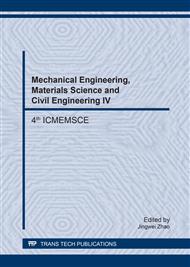[1]
Y.Y. Sun, Q. Liang, H. J. Chi, Y. J. Zhang, Y. Shi, D. N. Fang, and F. X. Li, The Application of Gas Plasma Technologies in Surface Modification of Aramid Fiber, Fibers. Polym. 15 (2014) 1-7.
DOI: 10.1007/s12221-014-0001-x
Google Scholar
[2]
Y.Y. Chu, X. G. Chen, D. W. Sheel and J. L. Hodgkinson, Surface modification of aramid fibers by atmospheric pressure plasma-enhanced vapor deposition, Text. Resea. J. 84(2014) 1288–1297.
DOI: 10.1177/0040517513515311
Google Scholar
[3]
Rodriguez-Uicab. O, Aviles. F, Gonzalez-Chi. P. I, Canche-Escamilla. G et al, Deposition of carbon nanotubes onto aramid fibers using as-received and chemically modified fibers, Appl. Surf Sci. 385 (2016) 379-390.
DOI: 10.1016/j.apsusc.2016.05.037
Google Scholar
[4]
S. Li, K.Q. Han, H.P. Rong, X.Z. Li, M.H. Yu, Surface Modification of Aramid Fibers via Ammonia-Plasma Treatment, J. Appl. Polym. Sci. 131 (2014) 40250.
DOI: 10.1002/app.40250
Google Scholar
[5]
Aranganathan. N, Mahale. V, Bijwe. J, Effects of aramid fiber concentration on the friction and wear characteristics of non-asbestos organic friction composites using standardized braking tests, Wear. 354 (2016) 69-77.
DOI: 10.1016/j.wear.2016.03.002
Google Scholar
[6]
D. Yu, S.P. Mu, L.L. Liu, W. Wang, Preparation of electroless silver plating on aramid fiber with good conductivity and adhesion strength, Coll Surf A-Phys Eng Aspe. 483 (2015) 53-59.
DOI: 10.1016/j.colsurfa.2015.07.021
Google Scholar
[7]
C.X. Jia, P. Chen, Q. Wang, J. Wang, X.H. Xiong, K.M. Ma, The Effect of Atmospheric-Pressure Air Plasma, Discharge Power on Adhesive Properties of Aramid Fibers, Polym. Comp. 37 (2016) 620-626.
DOI: 10.1002/pc.23219
Google Scholar
[8]
Z. Sun, S. S. Shi, X. Z. Hu, X. Guo et al. Short-aramid-fiber toughening of epoxy adhesive joint between carbon fiber composites and metal substrates with different surface morphology. Compos. Part B: Engi. 77 (2015) 38-45.
DOI: 10.1016/j.compositesb.2015.03.010
Google Scholar
[9]
MA Karim Biswas, MA Shayed, RD Hund and Ch Cherif, Surface modification of Twaron aramid fiber by the atmospheric air plasma technique, Text Resea. J. 83 (2012) 406–417.
DOI: 10.1177/0040517512464291
Google Scholar
[10]
P. Cai, Z. L. Li, T. M. Wang and Q. H. Wang, Effect of aspect ratios of aramid fiber on mechanical and tribological behaviors of friction materials, Tribo. Inter. 92 (2015) 109-116.
DOI: 10.1016/j.triboint.2015.05.024
Google Scholar


